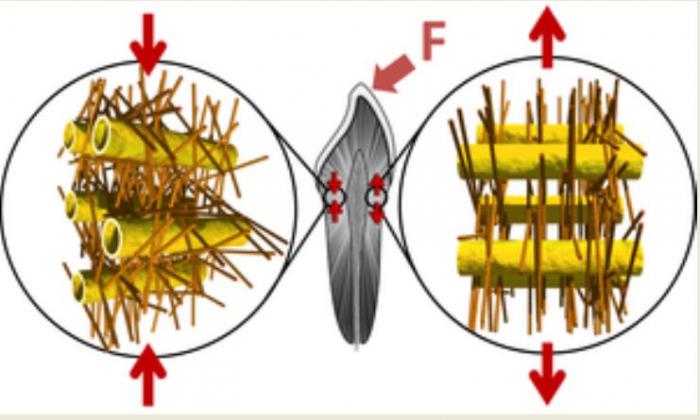Several theories have attempted to explain how our teeth manage to withstand the huge
stresses we inflict on them every day of our lives. Now a new study shows how mineral
nanoparticles and surrounding collagen in tooth dentin respond to stress in a way that prevents
cracks from spreading inside teeth.

Dentin tubules surrounded by mesh of collagen fibers in which mineral nanoparticles – not visible in this image – are embedded.
Image credit: Jean-Baptiste Forien Charité Universitätsmedizin Berlin
Normally, when bone gets damaged, because it is partly made of living cells, it can heal
itself by growing new tissue or remodeling. But while teeth are bone-like, they do not have this
facility. So how do they survive a lifetime of wear and tear?
In the journal Nano Letters, researchers led by members from the Charité
Universitätsmedizin Berlin in Germany describe how they examined the mechanical properties of
tiny nanoparticle and fiber structures inside dentin – the layer of softer, porous material that
lies under the much harder enamel covering of teeth.
The researchers already knew that dentin contains tiny layered structures of mineral
nanoparticles embedded in, and firmly attached to, collagen protein fibers.
And while it was thought these layers of mineral nanoparticles and collagen proteins make
teeth tough and damage resistant – it was not clear how they stopped cracks from growing.
Mineral nanoparticles in collagen structures in dentin are ‘pre-compressed’
The new study reveals that the nanoparticles are “pre-compressed” and it is this that stops
cracks from traveling, as senior author Dr. Paul Zaslansky of the Julius Wolff Institute of the
Charité explains:
“The compressed state helps to prevent cracks from developing and we found that
compression takes place in such a way that cracks cannot easily reach the tooth inner parts,
which might damage the sensitive pulp.”
Engineers use compression to strengthen industrial materials for stress-bearing jobs such as
gears and turbine blades. Now this study reveals that evolution may have arrived at this
solution in teeth long before industrial man.
The researchers examined the tiny structures of tooth dentin using micro- and nanofocused X-ray beams generated by advanced synchrotron-based diffraction equipment, some of which is based
at the European Synchrotron Radiation Facility in Grenoble, France.
They altered the humidity of dentin samples to change its mechanical properties and study how
stress was generated in the material.
They found that when the collagen fibers shrank, this increased the compression in the
attached mineral nanoparticles.
In further tests, they found that heat weakens the link between the nanoparticles and the
fibers, making the dentin more brittle.
Study may lead to tougher ceramic materials for tooth replacements
First author Jean-Baptiste Forien, a PhD student in the Julius Wolff Institute, says:
“We therefore believe that the balance of stresses between the particles and the protein is
important for the extended survival of teeth in the mouth.”
The team suggests their findings may explain why artificial tooth replacements are not as
resilient as healthy, natural teeth. Perhaps ceramic materials are too “passive” and do not
respond to stress in the same way as the natural, pre-compressed structures.
Dr. Zaslansky concludes:
“Our results might inspire the development of tougher ceramic structures for
tooth repair or replacement.”
Earlier this year, MNT learned how a team led by National Taiwan University is
developing a durable biomaterial to reduce tooth sensitivity.
Writing in the journal ACS Nano, the researchers note how their tests on dogs showed
the new biomaterial plugged exposed dentinal tubules more deeply than other treatments.
Written by Catharine Paddock PhD